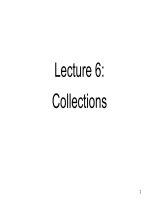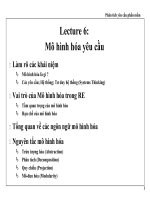Lecture+6+ +self+managed+learning+(part+a)
Bạn đang xem bản rút gọn của tài liệu. Xem và tải ngay bản đầy đủ của tài liệu tại đây (3.35 MB, 46 trang )
1
1. Self - Awareness
1.1. Self-awareness and professional development.
According to Goleman, 1998, self awareness can be an invaluable tool
for self development in several ways.
• Self awareness motivates change.
All workplace competencies (sufficiency of skills and experience) are
learned habits – as learn to improve ourselves – if we are deficient
(lacking) in one or another, we can learn to do better.
2
1. Self - Awareness
1.1. Self-awareness and professional development.
• Self awareness implies openness to feedback
In general, external feedback is the more accurate predictor of actual job
performance.
• Self awareness includes knowing one’s strengths and weaknesses
and approaching work accordingly.
Managers can function more effectively and less stressfully by making allowances for
their underlying (basic / original) personality traits and type preferences.
3
1. Self - Awareness
1.1. Self-awareness and professional development.
• Self awareness enables self control.
Recognizing how events and circumstances ‘trigger’ (activate / produce) unhelpful
behaviors enables us to be more intentional about generating alternative, and more
helpful, responses.
•Self awareness helps us to identify, manage and appreciate
difference.
We can utilize the complementary strengths of others and manage the potential for
incompatibility. If we are aware of our values, attitudes and perceptions, we will be
more ready to acknowledge that in an increasingly diverse work place, others may be
operating from a different view of the world
4
1. Self - Awareness
1.1. Self-awareness and professional development.
• Self awareness helps us to clarify our values and goals.
We will be more motivated, intentional and congruent (matching) in our behaviors.
1.2. Selective self perception
• Self image – the mental picture we have of ourselves – is influenced by:
How we see ourselves, what we think of our appearance, behavior, attributes, etc.
The reactions we get from other people and the conclusions we draw from those
reactions about the sort of person we are.
5
1. Self - Awareness
1.2. Selective self perception
• Self image – Cont’d…
How we would like to be (and see ourselves) – our ‘ideal self image’ –
and how we would like others to see us.
The culture of our family, organization, society, which determines the
values we attach to particular attributes (characteristics).
6
1. Self - Awareness
1.2. Selective self perception
• Self – image is highly subjective (personal / illusory).
there will be areas of our personality and behavior that we are not
aware of, and may not wish to become aware of. These ‘blind spots’
may be created by seeing only what we expect to see and ignoring
inconsistent information, or by seeing only what we want to see and
ignoring dissonant (disagreeing) information.
7
1. Self - Awareness
1.2. Selective self perception
• Self – image is highly subjective – Cont’d…
many of its components will be loaded with value judgments: whether
you see yourself as an attractive or good person, how you rate your
abilities and so on.
Since self-image is highly subjective and selective, and its influence on
behavior is largely subconscious, the checking of our self perceptions
is vitally (very / truly) important
8
1. Self - Awareness
1.3. Through the Johari Window
Johari Window is a useful framework for looking at
self – awareness, blind spots, and perception
checking. It classifies behaviors on a simple
matrix: the horizontal axis representing what is
known-unknown to self and the vertical axis
represent what is know-unknown to others.
9
1. Self - Awareness
1.3. Through the Johari Window – Cont’d…
Known to others
Public
Blind
(Obvious behaviors)
(Blind behaviors to yourself)
Known
to self
Unknown
to self
Hidden
Unknown
(Aware behaviors)
(not consciously noticed)
Unknown to others
10
1. Self - Awareness
1.3. Through the Johari Window – Cont’d…
• Some behaviors are obvious to you and to others: these are your public
behaviors.
they can be used in interpersonal interactions since both parties are able to
perceive and take them into account.
• Things you are aware of in yourself, but do not communicate to other people
are hidden behaviors.
they limit interpersonal interactions since they create
misunderstanding and neglect opportunities for feedback.
potential
for
11
1. Self - Awareness
1.3. Through the Johari Window - Cont’d…
• Behaviors are obvious to others, but yourself are not aware of are blind
behaviors.
potentially limit interpersonal interactions, as they may undermine your conscious
intentions and messages.
• Some are not consciously noticed by you or by others are unknown
behaviors.
wasted in interpersonal interactions: not currently available for use.
12
1. Self - Awareness
1.3. Through the Johari Window - Cont’d…
• The process of developing self awareness involves:
reducing unknown behaviors, by bringing them into your awareness through
self – observation, reflection and assessment.
reducing blind behaviors of others’ perceptions of you through feedback
seeking
• Managing hidden behaviors
through self – disclosure to others, as relevant to the requirements of the
interaction and appropriate to the level of trust and intimacy in the relationship
13
2. Managerial learning and
development
2.1 The nature of managerial learning and development
• Managers’ own responsibility for identifying and satisfying their learning
needs
• competence-based (skills and knowledge) training allowing individuals to
identify and take advantage of learning opportunities in the work-place.
• experiential learning rather than knowledge-based curricular
• Continuous-self development, aimed at personal competence and
employability rather than job-specific performance improvement
14
2. Managerial learning and
development
2.2 The experiential learning cycle
• Self-development approach based on increasing self-awareness takes these
elements into account by giving you flexible competencies and approaches
which allow you to
set your own life and career-relevant learning and problem-solving goals.
plan to exploit development opportunities in your work place
apply the experiential learning cycle to utilize any experience or action as
a learning opportunity
incorporate theoretical knowledge reflection, practice and application for
effective competence development
practice balanced learning habits and skills which will enable on-going
development throughout your lifetime.
15
2. Managerial learning and
development
2.2 The experiential learning cycle
Stage 1
Having an
experience
Stage 4
Stage 2
Planning
the next
steps
Reviewing
the
experience
Stage 3
Concluding
from the
experience
Fig 18.2 Honey and Mumford’s
learning cycle
16
2. Managerial learning and
development
2.3 Learning styles
Styles
Activist
‘I’ll try anything once’
Characteristics
• Involve fully in new
experiences
• Open-minded,
enthusiastic about new
things
• Easy to get bored by
long term implementation
and consolidation
• Prefer to tackle problems
by brainstorming
Learning
preferences
Learn best from
activities which:
•
• Present new
experiences/problems
• Involve short ”here and
now” activities
• Offer excitement drama
and variety
• Have high visibility/
limelight
17
2. Managerial learning and
development
2.3 Learning styles – Cont’d…
Styles
Activist
‘I’ll try anything once’
Characteristics
• Easily get involved with
others, but tend to centre
activities on themselves
Learning preferences
Learn best from
activities which:
• allow them to generate
ideas without constraints
of structure or feasibility
• challenge/throw them in
at the deep end
• involve them with other
people
• allow them to ‘have a
go’
18
2. Managerial learning and
development
2.3 Learning styles – Cont’d…
Styles
Activist
‘I’ll try anything once’
Characteristics
Learning preferences
Learn least from
activities which
• Involve passive roles
and processes of
structure or feasibility
• Don’t allow involvement
• Require the handling of
“messy” data
• Require solitary work
19
2. Managerial learning and
development
2.3 Learning styles – Cont’d…
Styles
Activist
‘I’ll try anything once’
Characteristics
Learning preferences
Learn least from
activities which
• Involve precise
instructions, repetition
(practice) and ‘theoretical’
concepts
• Require follow-up or
attention to detail
20
2. Managerial learning and
development
2.3 Learning styles – Cont’d…
Styles
Characteristics
Reflector
• Like to stand back to
‘look before you leap’
observe and ponder new
experiences
• Prefer to consider all angles
and implications
• Analyze all available data
before reaching any
conclusion and making any
moves
• Awareness of a big picture
Learning preferences
Learn best from
activities which
• Encourage observation
and reflection
• Allow them to stand back
from events
• Allow them to think
before acting
• Involve painstaking
research
21
2. Managerial learning and
development
2.3 Learning styles – Cont’d…
Styles
Characteristics
Reflector
• Adopt a low profile
‘look before you leap’
• Take a back seat in
meetings and discussions
• Have a slightly distant,
tolerant, unruffled air.
Learning preferences
Learn best from
activities which
• Offer an opportunity for
review
• Help them to exchange
views with others without
risk, with structure
22
2. Managerial learning and
development
2.3 Learning styles – Cont’d…
Styles
Reflector
‘look before you leap’
Characteristics
Learning preferences
Learn least from
activities which
• Force them into the
limelight (public eyes)
• Require action without
warning/planning
• Give insufficient data
• Give analyzed practical
instructions
• Impose time pressures
especially if there
necessitate shortcuts
23
2. Managerial learning and
development
2.3 Learning styles – Cont’d…
Styles
Characteristics
Theorist
• Keen on basic assumptions
‘if it’s logical it’s good’
principles , theories, models,
and systems thinking
• Detached and analytical
• Maximize certainty
• Be rigidly perfectionist
Learning preferences
Learn best from activities
which
• Relate to a system, model
or theory
• Allow time to grasp
underlying logic
• Display rationally or logic
• Have clear purpose and
structure
• Allow
analysis/generalization of
reasons for success/failure
24
2. Managerial learning and
development
2.3 Learning styles – Cont’d…
Styles
Theorist
‘if it’s logical it’s good’
Characteristics
Learning preferences
Learn least from
activities which
• Have no context of
apparent purpose
• Emphasize emotions or
feeling
• Involve ambiguity and
uncertainty
• Require them to act or
decide without a basic in
policy principle or concept
25









